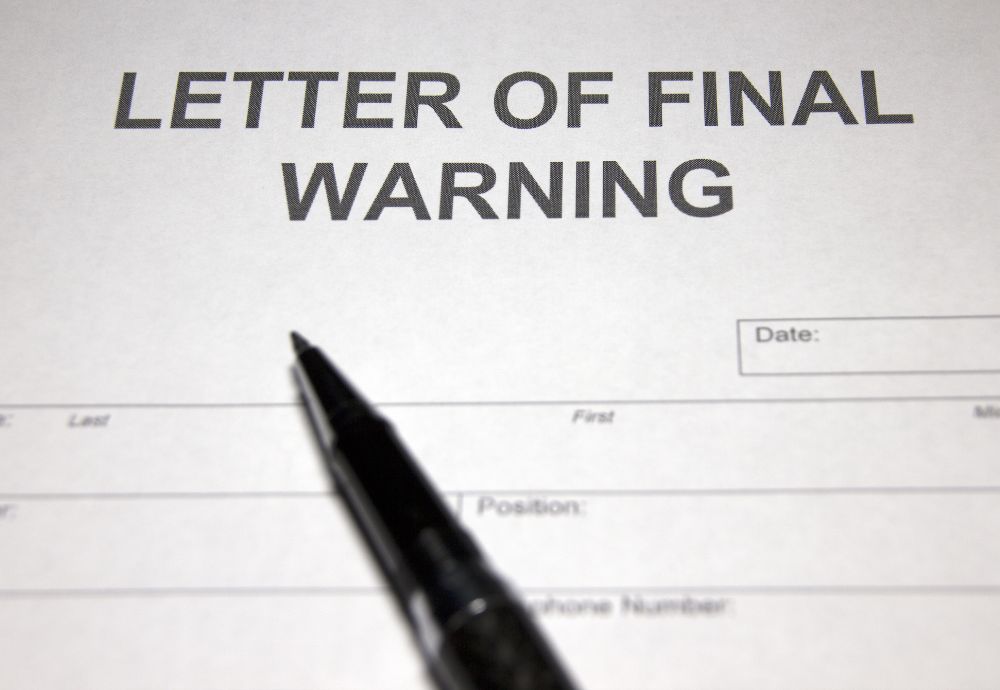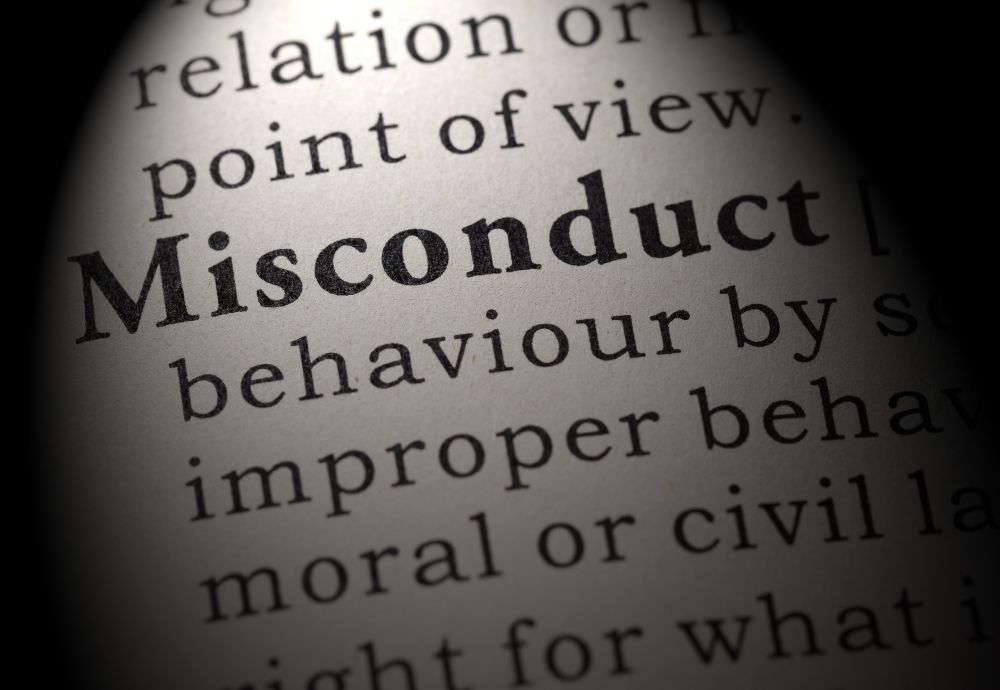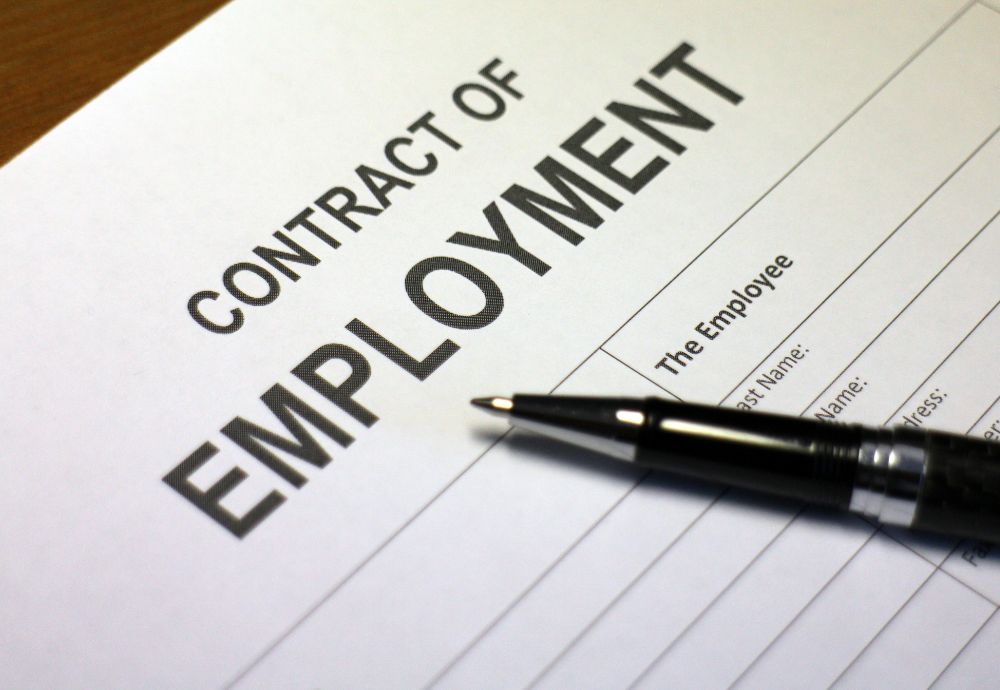First published on Thursday, June 4, 2020
Last updated on Wednesday, February 7, 2024
Managing employees is no easy task. You will often find yourself in situations where you need to address a problem with an employee, but what should you do if the problem continues?
When a disciplinary issue continues to persist, despite a previous verbal warning and first written warning, a final written warning becomes a viable asset in your HR toolkit.
In this article, we will delve deeper into what a final written warning is, explore when to use it, and thoroughly detail the process for handling it professionally and effectively.
What is a final written warning?
A final written warning is a formal document issued by an employer to an employee, typically for serious performance issues or misconduct. It's used as part of a fair disciplinary process.
This disciplinary action informs the employee that their behaviour or performance is not meeting the expected standards per the employee's contract, and it serves as a final opportunity for the employee to rectify their actions before facing more severe consequences, such as dismissal.

When should you issue final written warnings?
Before you decide to issue a final written warning, it's important to exercise fair judgment and consider various factors.
These factors may include the severity and frequency of the employee's performance or behavioural issues, the impact on the team or business, and whether the employee was given enough prior disciplinary warnings and opportunities to improve.
Make sure to take all of these factors into account before making a final decision. There are several steps in the disciplinary procedure you must follow first for it to be considered a fair disciplinary process.
So, when dealing with poor performance or minor misconduct, it's important to start with informal disciplinary actions such as a chat or warning, especially if it's their first offence. If the employee fails to improve, disciplinary action should then be taken formally.
The disciplinary process
Following a disciplinary process when you issue a final written disciplinary warning, can help to make the process fair. A formal disciplinary procedure involves the following steps:
Step 1 - Establish the facts of the investigation
Step 2 - Tell the employee about the problem in writing
Step 3 - Give evidence that you have collected or relevant information to the employee
Step 4 - Invite the employee to a meeting (disciplinary hearing) in writing
Step 5 - Inform the employee of their right to have a colleague or trade union representative accompany them, in writing
Step 6 - Hold a disciplinary meeting to discuss the problem
Step 7 - Allow them to explain their misconduct or poor performance issues
Step 8 - Decide the appropriate course of action
Step 9 - Tell them what improvements need to be made, how to make them, and timeframes for change
Step 10 - Give them a chance to appeal
The usual outcome at this stage for managing misconduct or poor performance would typically be a verbal warning or a first written warning depending on the circumstances. This gives your employees a chance to improve their performance issues or conduct before a final warning is issued.
This isn’t always the case as there are certain circumstances when a final written warning can be issued without going through this process, such as cases of serious insubordination or gross misconduct.
What are the reasons for issuing a final warning?
The decision to issue a final written warning is not one to be taken lightly, but there are certain reasons why you would use a final written warning:
Repetitive issues
A final written warning is usually appropriate when an employee exhibits a pattern of misconduct or underperformance despite a previous verbal warning or written warning. It's a signal that their behaviour needs immediate correction.

Gross misconduct or serious misconduct
For serious misconduct where your employee's behaviour has caused serious harm to your business or their coworkers, for example, if your employee's actions led to a financial loss, a final written warning can be the last formal step before termination.
This demonstrates that your business is following due process and is committed to treating all employees fairly.
But when it comes to gross misconduct such as physical violence, or gross negligence, you may dismiss your employee on the spot without giving them a final warning.
For more on gross misconduct, you can read our article on gross misconduct at work.
Policy violations
When an employee continually breaches company policies, it's essential to address the issue formally through a final written warning. This can also be applicable in cases of repeated lateness and excessive absenteeism.
What is the right way to issue a final written warning?
When done correctly, a final written warning provides your employees with a clear path for improvement, helps you maintain fairness and consistency within your business, and protects you from legal liabilities such as an unfair dismissal claim.
These steps will help you issue a final written warning the right way, making sure you cover all the bases to help your employee improve and keep things on the up and up.
Clearly document the employee's conduct
Document instances of misconduct or performance issues accurately. Be specific about what the problem is, when it happened, and the impact it had on the workplace.
Keep a record of previous warnings or discussions related to the issue, only if the warning has not expired.
Conduct a thorough investigation
Before issuing a final written warning, ensure that you have conducted a fair and comprehensive investigation into the matter at hand.
Collect evidence, speak with relevant parties involved, and gather all the necessary information to decide if there is a case.

Hold a disciplinary meeting
If you decide there is a case, then invite the employee in writing, to discuss the issues at hand. Make sure to explain the allegations, include evidence gathered during the investigation and include their right to be accompanied in the letter.
During the meeting begin with an open, non-confrontational conversation to create a calm atmosphere for constructive dialogue. Present your concerns and provide the employee with an opportunity to explain their side of the story.
It's essential to maintain professionalism throughout this process.
The written warning letter
If, after the meeting, you believe that a final written warning is necessary, provide the employee with a formal written warning letter.
This letter should be well-drafted, outlining the problem clearly, referencing any previous warnings (that have not expired), and specifying the consequences if the issue persists.
It should be factual, unemotional, and clearly state the seriousness of the matter.
Feedback and improvement plan
As part of the final written warning process, it's best practice—if appropriate to the case—to offer constructive feedback to the employee.
Work collaboratively with them to create an improvement plan. Set clear expectations and provide them with a timeline for making the necessary improvements.
This shows that your aim is not merely to punish them but to support their growth.
Follow up
After issuing the final written warning, schedule regular follow-up meetings to track the employee's progress.
Make sure they have the necessary resources and support they need to succeed. Offer guidance and make it clear that you're invested in their improvement. Keep detailed records of these follow-up meetings as well.
By following this process, you can strike a balance between accountability and support while fostering a workplace that values continuous improvement.
The dos and dont's of final written warnings
Do:
- Be fair and consistent with all employees. Make sure you treat all employees equally and don't show favouritism.
- Maintain professionalism throughout the process. Avoid becoming emotional or engaging in confrontational behaviour.
- Keep detailed records of all communication related to the issue. This includes records of meetings, warnings, and any performance improvement plans (if applicable).
- Offer a support system for your employees to help them succeed. Encourage their growth, provide training if necessary, and be ready to make reasonable accommodations.
Don't:
- Issue a final written warning in anger or frustration. It should be a well-considered and logical decision.
- Use it as a surprise tactic. The employee should be aware of the seriousness of the issue well in advance of receiving the final written warning.
- Use a final written warning as a means of retaliation. It should always be based on well-documented and legitimate concerns.
- Neglect to follow through with consequences if the issue persists. If the employee does not meet the specified improvement goals, you should take appropriate action.
Legal consideration for final written warnings
Issuing final written warnings to employees in the UK comes with legal considerations that aim to ensure fairness, compliance with employment laws, and protection for both you and your employee.
Key legal considerations for final written warnings in the UK include:
A fair procedure
You should follow a fair and consistent disciplinary procedure. This includes conducting a thorough investigation, providing the employee with a clear statement of the allegations against them, and allowing the employee an opportunity to respond and present their side of the story.
Equality and non-discrimination
You should make sure that your own employer's disciplinary policy or process does not discriminate against employees on the basis of protected characteristics such as age, race, sex, disability, religion, or belief. Warnings should be issued without bias.
Consistency
You should apply the same standards and procedures when issuing final written warnings to all employees to maintain consistency. Inconsistencies can lead to legal challenges.

Employment contracts
Make sure that the dismissal procedure for warnings is clearly defined in your employee's employment contract, staff handbook, or relevant company policies. This includes the process, potential consequences, and the appeal process.
Duration of the warning
The duration for which a warning is recorded depends on the level of severity of the offense. A warning typically remains on record for a period of 6 months, while a final written warning may remain on record for up to 12 months.
However, there may be instances where a warning remains on record indefinitely. The duration that the warning will remain on record must be clearly stated in the confirmation of disciplinary action letter or in your business's policies and procedures—or ideally, in both.
Right to appeal
It's important to note that employees have the right to appeal a final written warning. To make sure that this process is carried out smoothly, the appeal process should be clearly communicated to all employees.
The purpose of the appeal hearing is to allow you to listen to the points of appeal raised by the employee. Ideally, the appeal hearing should be chaired by someone who has not been involved in the case before and who holds a more senior position than the person who conducted the disciplinary hearing.
Record-Keeping
You should maintain thorough records of the disciplinary process, including the warning itself, any meetings or discussions, and the employee's response. This paper trail can be crucial if legal issues arise.
Trade Union or Employee Representatives
Employees have the right to be accompanied by a trade union representative, an official employed by a trade union or a colleague during disciplinary meetings. You must respect these rights.
Unfair Dismissal Claims
Failure to follow a fair disciplinary procedure, including issuing a final written warning or immediate dismissal, can lead to unfair dismissal claims. You must be able to demonstrate that the warning was issued for legitimate reasons and after following a fair procedure.

Data Protection
You should also consider data protection laws such as the General Data Protection Regulation – GDPR when handling and storing information related to final written warnings. Personal data must be handled in compliance with data protection regulations.
It's best practice to seek legal advice and make sure that your disciplinary processes, including issuing final written warnings, are following UK employment laws and regulations to minimise legal risks and maintain a fair and just workplace.
How BrightHR helps with a final warning or formal warning at work
While final written warnings are an essential aspect of managing a workforce, they should always be a last resort. You shouldn’t rush to discipline anyone, but instead, encourage improvement and keep the workplace harmonious.
Navigating this challenging HR process can be tough as an employer, but with the right guidance, you can conduct it in line with the law and avoid employee claims.
Remember, issuing a final written warning should be the result of a thoughtful and well-documented process, and your ultimate aim should be to help your employee succeed. After all, a happy, well-performing team benefits everyone involved.
BrightHR has the resources you need to properly issue a final written warning. From BrightAdvice, your own expert legal advice team—who are available 24/7 to answer your questions and provide support—to BrightBase our library of hundreds of expertly written policies, templates, and guides for employment contracts, handbooks, and warning letters.
Not a BrightHR customer yet? Discover more by booking your free demo.
Have a question?
Ask away, we’ve got lightning fast answers for UK business owners and employers powered by qualified experts.


